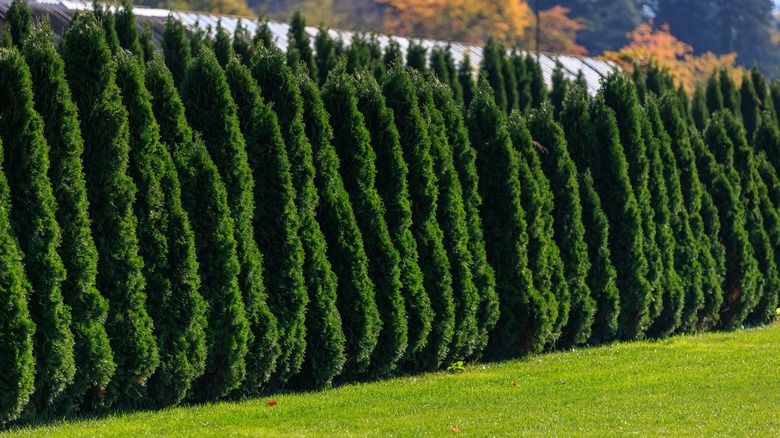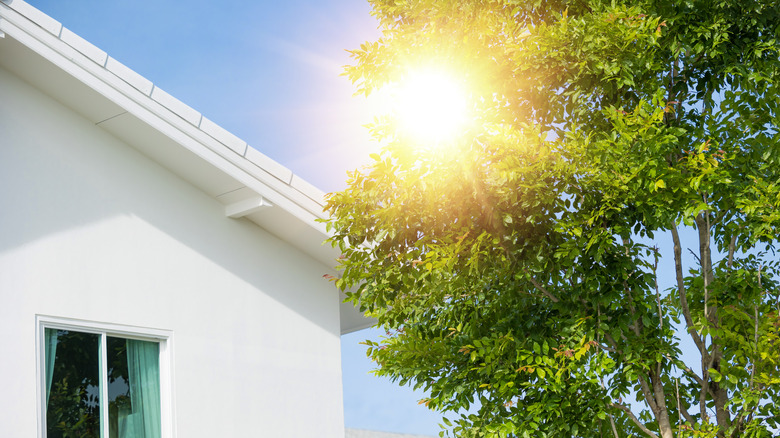Planting The Right Trees Can Help Reduce Your Heating Costs During Winter
Trees are some of the longest-living creatures on Earth, so choosing which ones to plant on your property is no small decision — they could potentially be there for generations to come. Aside from attracting wildlife and adding beauty, there's another potential benefit to keep in mind: When properly placed, evergreen trees with low, dense crowns can keep your energy costs down in the winter.
Trees might not be the first thing to come to mind to keep your home warm, aside from perhaps as firewood, but they have measurable effects on their environments that can reduce energy usage by up to 25% in winter and summer alike. It's all about planting the right trees in the right places for your local climate.
In cold weather, icy winter winds make the temperature feel much cooler, sucking the warmth out of your home and leaving your heating system working overtime. Wind can also get into your house through small cracks in addition to potentially damaging tree limbs or buildings. A few rows of dense evergreen trees and shrubs can act as a windbreak, deflecting those arctic blasts and helping you stay warm and cozy all winter.
How to build a windbreak
The best windbreak trees are evergreen rather than deciduous, meaning they keep their leaves all winter. That foliage is vital for physically blocking and breaking up wind, reducing the wind's speed and redirecting it from your home. Trees can reduce the wind's speed by up to 50% and remain effective for a distance of 30 times the mature height of the trees. This makes it easier for your heating system to keep your home at a comfortable temperature.
To build a gorgeous windbreak that lasts, choose trees with low, dense crowns, which are better able to block wind close to the ground. Species to consider include firs, spruces, junipers, pines, and evergreen shrubs. Plant upwind of your house and perpendicular to winter winds. Typically, this means the north, west, or northwest. It's best to plant one or two rows if they're dense, or additional rows if they're sparse, at a distance of around two to five times the mature height of the trees. The trees should be close enough that their crowns will eventually meet as they grow.
To further lower heating costs, combine the tree windbreak with a wall or fence to help lift winds above the home. Leave the south side of the home clear so that the sun's light can still make it to your windows, providing extra heat. You can also help insulate your home by planting shrubs, vines, or bushes close by (about 1 foot away). Add low shrubs on the windward side of the windbreak as well (on the opposite side of it as your house) to trap snow and keep your home clear.
What about warmer climates?
Full windbreaks aren't the right choice for everyone. The best way to landscape for energy efficiency depends on what type of climate you live in, and for those in temperate and hot regions, summer cooling is equally or more important than winter heating. To maximize energy savings year-round, trees should provide shade in the summer to cool the air around your home and channel summer breezes — then, in winter, block winds and allow the sun's heat through their bare branches.
Rather than evergreens, plant small or medium deciduous trees with high crowns that spread wide. The east and west sides of the house are typically ideal, but the right location and distance from the house will depend on a range of factors, including where the sun hits your windows or walls, the direction of the wind, and how tall the trees are. Too close at the wrong angle and you risk losing sunshine in winter, not to mention the many potential safety hazards of tree roots and branches near your home. As you plan, always keep in mind the mature size of the trees and how quickly they grow. Slower-growing trees will take time to offer the maximum energy savings.
With so many tree species to choose from, consulting an arborist or nursery professional is an essential step in planning. They can help you find species that grow well in your area and help you pick the most suitable planting locations for your energy-saving goals. You can even score a free tree for your yard with a program like the Arbor Day Foundation's Energy-Saving Trees, which will also provide advice on where to plant them.


